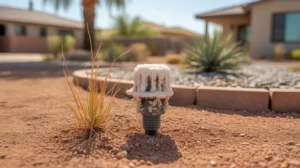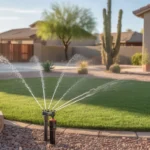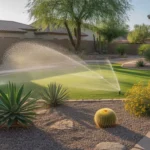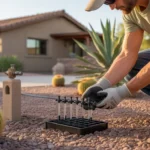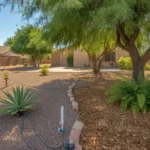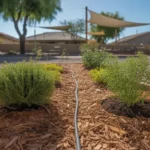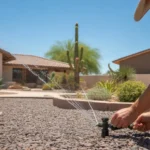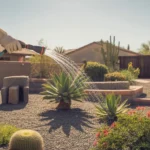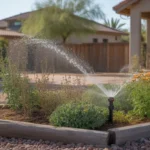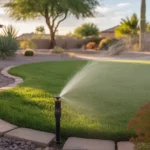Irrigation systems are a lifeline for Queen Creek landscapes, delivering essential hydration to plants, trees, and turf. However, over time, these hardworking systems can fall victim to a common issue: salt buildup. Mineral deposits gradually accumulate inside pipes and emitters, restricting water flow and potentially harming plant health. Fortunately, with proactive maintenance and a few smart strategies, you can break free from salt buildup and keep your irrigation system running smoothly.
Understanding Salt Buildup in Queen Creek
In arid regions like Queen Creek, water sources often contain high levels of dissolved minerals, including calcium, magnesium, and sodium. As water evaporates from the soil or during irrigation, these minerals are left behind, forming crusty deposits known as salt buildup or scale. Over time, this accumulation can clog drip emitters, reduce water pressure, and even alter soil chemistry.
The unique soil composition in Queen Creek can exacerbate the problem. Our alkaline, clay-heavy soils tend to hold onto salts more readily than sandy or loamy soils. This means that even with high-quality irrigation water, salt buildup can still occur as minerals are drawn up from the soil itself. Regular flushing and maintenance are essential to combat this natural process.
Signs of Salt Buildup in Your Irrigation System
Identifying salt buildup early can save you from costly repairs and plant damage down the line. Keep an eye out for these telltale signs:
- Reduced water flow from drip emitters or sprinkler heads
- Crusty white deposits around emitters or on the soil surface
- Wilting, yellowing, or stunted growth in plants despite adequate watering
- Uneven water distribution, with some areas receiving more water than others
If you notice any of these symptoms, it’s time to take action and flush out your irrigation system. Catching salt buildup early can prevent more serious issues like clogged pipes or emitter failure.

How to Flush Your Irrigation System

Flushing your irrigation lines is the most effective way to remove salt buildup and restore proper water flow. Here’s a step-by-step guide:
- Turn off your irrigation controller and close the main water supply valve.
- Locate the flush valves or end caps on your irrigation lines. These are typically found at the lowest points of each zone.
- Place a bucket under the flush valve to catch the water and debris.
- Slowly open the flush valve and allow water to run until it comes out clear. This may take several minutes, depending on the severity of the buildup.
- If water remains cloudy or you see a lot of debris, consider adding a cleaning solution to the lines. Mix one part vinegar or citric acid with four parts water, and pour it into the irrigation system through the flush valve. Let it sit for 30-60 minutes before flushing again with clean water.
- Repeat the process for each zone in your irrigation system.
- Once all zones are flushed, close the flush valves and turn the main water supply back on.
- Run each zone for a few minutes to check for proper operation and even water distribution.
Aim to flush your irrigation system at least twice a year, or more frequently if you notice signs of salt buildup. Regular flushing not only removes mineral deposits but also helps clear out any dirt, sand, or organic matter that may have accumulated in the lines.
Preventing Salt Buildup with Filtration
While flushing is an effective treatment for salt buildup, prevention is always the best medicine. One way to minimize mineral accumulation is by installing a filtration system on your irrigation line. There are several types of filters available, each designed to remove specific contaminants:
- Sediment filters: These trap sand, silt, and other particulates that can clog emitters and contribute to buildup.
- Carbon filters: Activated carbon removes chlorine, pesticides, and other organic compounds from irrigation water.
- Reverse osmosis (RO) systems: RO filters use a semi-permeable membrane to remove dissolved minerals, salts, and other impurities. They produce highly purified water but can be more expensive and require regular maintenance.
When choosing a filtration system for your Queen Creek irrigation, consider your water source, budget, and maintenance preferences. A professional irrigation specialist can help you select the best option for your needs.
Adjusting Your Irrigation Schedule
In addition to flushing and filtration, adjusting your irrigation schedule can help combat salt buildup. Overwatering can lead to excess mineral accumulation in the soil, as salts are drawn up with the water but left behind when it evaporates. To minimize this effect:
- Water deeply but infrequently, allowing the soil to dry out slightly between irrigation cycles. This promotes deeper root growth and reduces surface evaporation.
- Schedule irrigation for early morning or late evening, when temperatures are cooler and evaporation rates are lower.
- Install a smart irrigation controller that adjusts watering based on weather conditions, soil moisture, and plant needs. This helps prevent overwatering and reduces the risk of salt buildup.
By fine-tuning your irrigation schedule, you can maintain healthy soil moisture levels while minimizing the potential for mineral accumulation.
Choosing Salt-Tolerant Plants
Some plants are more sensitive to salt buildup than others. If you’re struggling with persistent mineral accumulation in your Queen Creek landscape, consider incorporating more salt-tolerant species into your planting design. Some options that thrive in our alkaline soils include:
- Desert marigold (Baileya multiradiata)
- Yellow bells (Tecoma stans)
- Texas sage (Leucophyllum frutescens)
- Red yucca (Hesperaloe parviflora)
- Deer grass (Muhlenbergia rigens)
These resilient plants can tolerate higher levels of salts in the soil and irrigation water, making them a smart choice for landscapes prone to buildup. As always, be sure to group plants with similar water needs together to maximize irrigation efficiency.
Maintaining a Healthy Irrigation System
Breaking free from salt buildup requires ongoing maintenance and attention. In addition to regular flushing and filtration, be sure to:
- Inspect your irrigation system monthly for signs of leaks, clogs, or damage. Repair any issues promptly to prevent water waste and uneven distribution.
- Clean or replace clogged emitters as needed. A toothpick or small wire can often dislodge minor blockages, while more stubborn clogs may require emitter replacement.
- Monitor your plants for signs of stress, such as wilting, yellowing, or stunted growth. These can indicate salt buildup or other irrigation issues that need addressing.
- Have your soil tested annually to check for nutrient imbalances or excessive salts. A professional soil analysis can guide your fertilization and amendment strategies.
By staying proactive and consistent with your irrigation maintenance, you can keep salt buildup at bay and ensure your Queen Creek landscape receives the hydration it needs to thrive.
Salt buildup may be a common challenge for Queen Creek irrigation systems, but with the right strategies and a little elbow grease, you can keep your pipes and emitters flowing freely. By flushing regularly, investing in filtration, adjusting your watering schedule, and choosing salt-tolerant plants, you’ll be well on your way to a healthier, more efficient irrigation system. Your landscape will thank you with lush, vibrant growth all season long.

